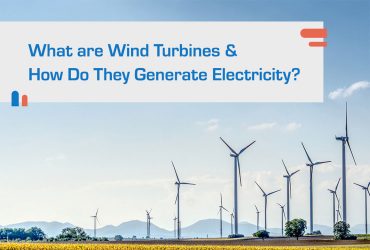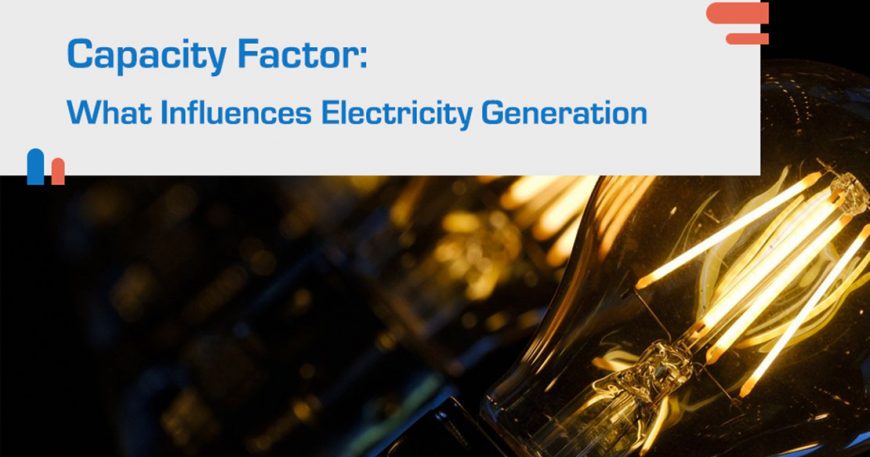
Capacity factor: influence on electricity generation
When evaluating the power generation performance of a wind turbine at a certain location, there are a few measurements that are commonly taken into consideration. Capacity factor of wind is one of them. Often confused with efficiency or power capacity of a wind turbine, capacity factor is actually a resulting calculation of both internal and external influences.
Capacity factor is not power capacity of a wind turbine
Power capacity of a wind turbine describes how much electrical power a wind turbine can generate with optimal wind resources. For example, our LS Double Helix 1.5 vertical axis wind turbine produces 1.5 kW electrical power at the nominal wind speed of 15 m/s. This means our wind turbine has a power capacity of 1.5 kW. In other words, the turbine is designed to have the power output of 1.5 kW.
Similarly, if an onshore horizontal axis wind turbine produces 2 MW (megawatt) at its nominal wind speed, it has a power capacity of 2 MW.
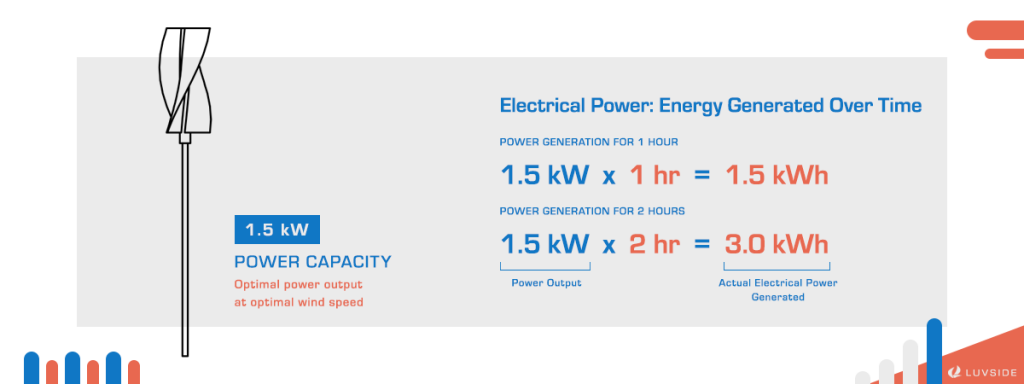
Power generation is measured over time
The amount of power generated from any source or consumed by any user is usually measured over time. More specifically, over the time unit of “hour.” For example, when a LuvSide wind turbine with the power capacity of 1.5 kW operates fully for one hour, it produces 1.5 kWh (kilowatt-hour) of electrical energy. If it operates fully for two hours, it produces 1.5 kW x 2 hr = 3.0 kWh of electrical energy.
Depending on its design, every wind turbine has a different ability to capture the energy in incoming wind and convert it into rotational torque that drives the generator. While this ability is mostly reflected in the wind turbine’s efficiency and power capacity, external factors also affect the amount of power produced by the turbine over time. This is when capacity factor comes into play.
Wind is not always strong, consistent, or present
How much electrical power a turbine can generate is largely dependent on the wind speed and consistency of incoming wind. At slower wind speeds, the power production decreases dramatically. When the wind speed drops by half, power production decreases eight times.
Take the LuvSide turbine for example. The LS Double Helix 1.5 turbine operates optimally at 15 m/s wind speed. When the wind speed is only 10 m/s, the turbine can only generate 1 kWh of energy in 1 hour. When the wind speed is 15 m/s but only blows for 0.5 hour, the same turbine generates only 0.75 kWh for that hour.
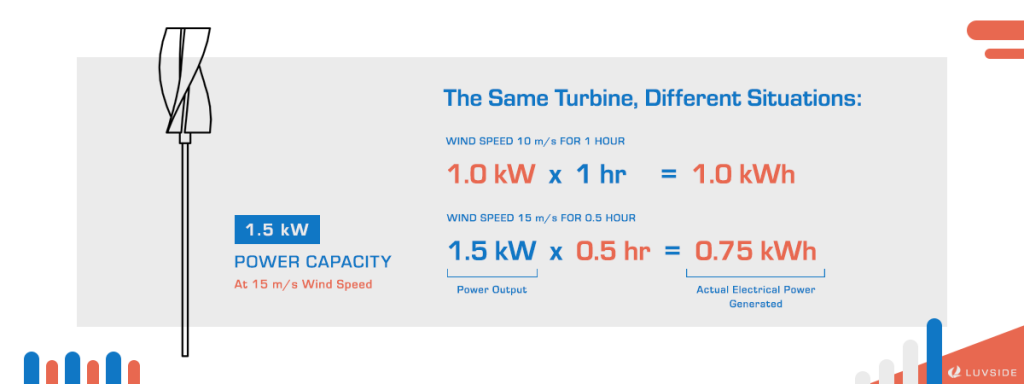
The math is clear. Wind does not always blow at the same speed for 24 hours a day, 365 days a year. Sometimes, the wind resources at a location changes seasonally. Sometimes, unexpected weather activities within the day decides how much wind is available. Because of this, a wind turbine might not always be operating at its nominal standard. There might be times where the wind turbine does not rotate at all due to the lack of wind.
Capacity factor of wind turbine describes the realistic power output
Capacity factor of wind turbines describes the gap between nominal and realistic power production of a wind turbine at a certain location over a period of time. It is the ratio of the wind turbine’s actual power output to its nominal or maximum power output.
Let’s take an easier explanation. In some museums, you can find a bicycle connected to a light bulb. When people ride the bicycle, they generate electrical power that lights the light bulb. Now, the light bulb has a 100% maximum lightness, but not every person is able to ride the bicycle fast enough to reach that.
Let’s assume it takes an Olympic cyclist to achieve 100% lightness with the bicycle. But now, we only get my grandpa. My grandpa is so slow, that he can only ride the bicycle to 30% of light bulb lightness. In this case, the capacity factor of the bicycle is 30%. Thanks to grandpa.
In this metaphor, the bicycle is the wind turbine. The light bulb represents power generated. The Olympic cyclist is the optimal wind speed, which we want for our turbine. However, my grandpa is the wind speed we actually get.
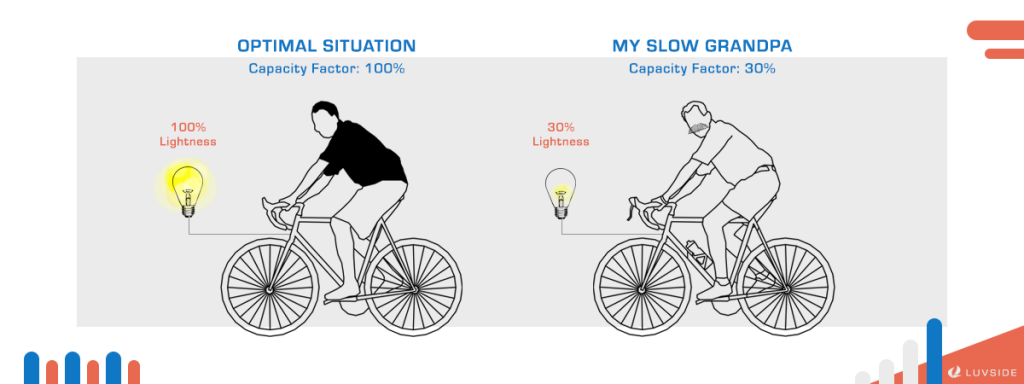
Capacity factor is influenced by many reasons and calculated over a period of time
Generally speaking, capacity factor is measured over a one-year period. Therefore, many different causes that happen throughout the year would affect the capacity factor of the wind turbine. These include wind speed, maintenance downtime, repair downtime, and others.
To calculate the capacity factor of a wind turbine, we take the actual power output of the turbine over the year and divide it with the optimal power output of the same time period.
Take LS Double Helix 1.5 wind turbine as an example again. Nominally, the wind turbine generates annually 13,140 kWh of electricity, assuming wind blows non-stop at 15 m/s for the whole year. However, in reality, the turbine only generated 2,628 kWh in that year because there wasn’t enough wind. In this case, the capacity factor of the wind turbine of that year is 2,628 kWh/ 13,140 kWh = 20%.
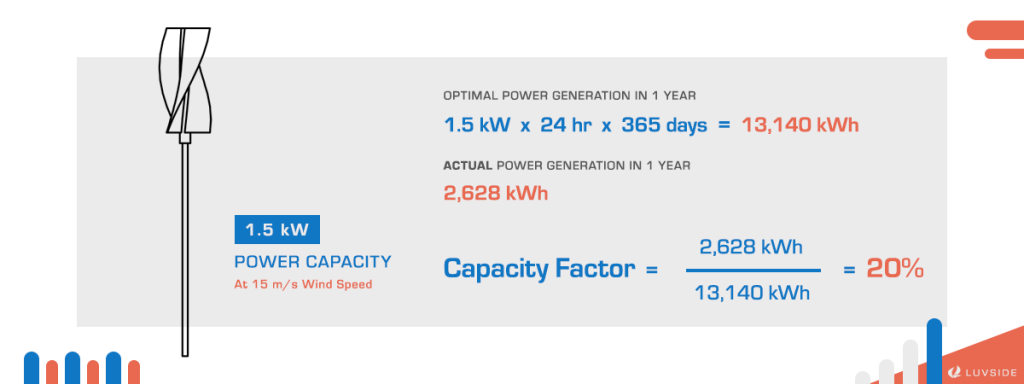
How to improve the capacity factor of a wind turbine
According to research, a wind turbine produces at or above its average rate around 40% of the time, meaning it produces little to no power 60% of the time due to various reasons. The average capacity factor of a wind turbine over one year usually falls between 20% to 30%, but there are still ways to improve the performance.
First of all, thorough planning before you install a wind turbine can help you maximize the capacity factor. It is very important to make sure that your chosen wind turbine site receives the optimal wind resources. This doesn’t only mean stable wind flow, but also ensuring there is little to no obstacle that could block incoming wind. The more wind resources the turbine receives, the more power it can potentially generate.
Secondly, capacity factors are not only decided by wind resources. The design of the wind turbine affects the turbine’s ability to pick up energy from incoming wind. Generally speaking, low wind speeds and turbulent wind are two main challenges for turbine operation.
Therefore, modern turbines that can generate power at lower wind speeds increase their capacity factors. Wind turbines that function under turbulent wind also have competitive advantages. Selecting the right type of wind turbine that operates best to your local wind condition is essential to ensure optimal power output.
Related Content
The energy transition has already reached urban areas. In addition to solar modules on roofs and green façades, small wind turbines are increasingly being considered...
Since centuries ago, humans have learned to utilize wind power for activities ranging from everyday tasks like grinding grains to long-distance traveling such as sailing....

